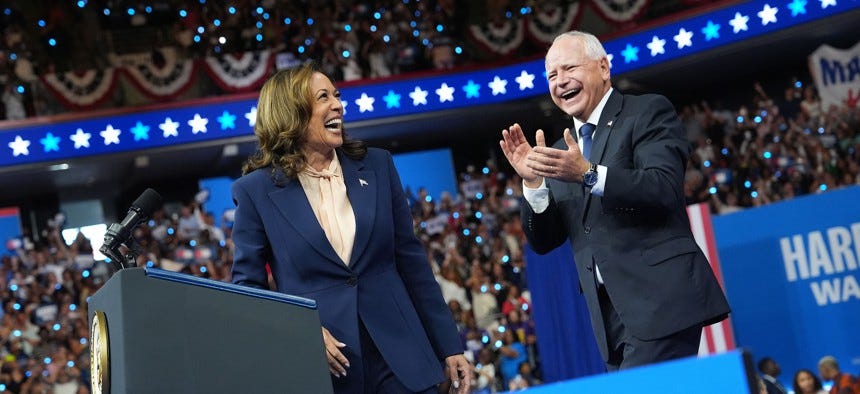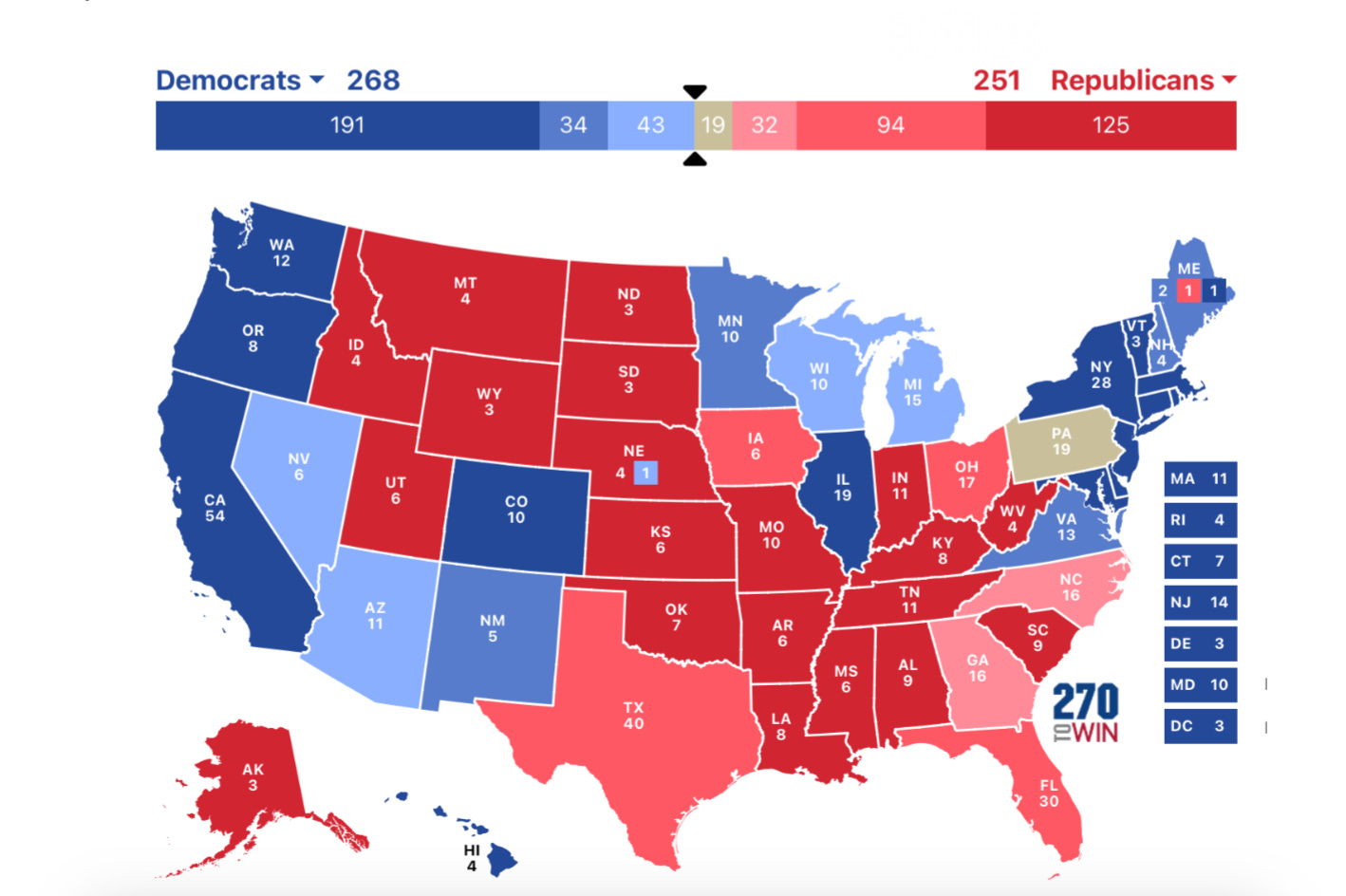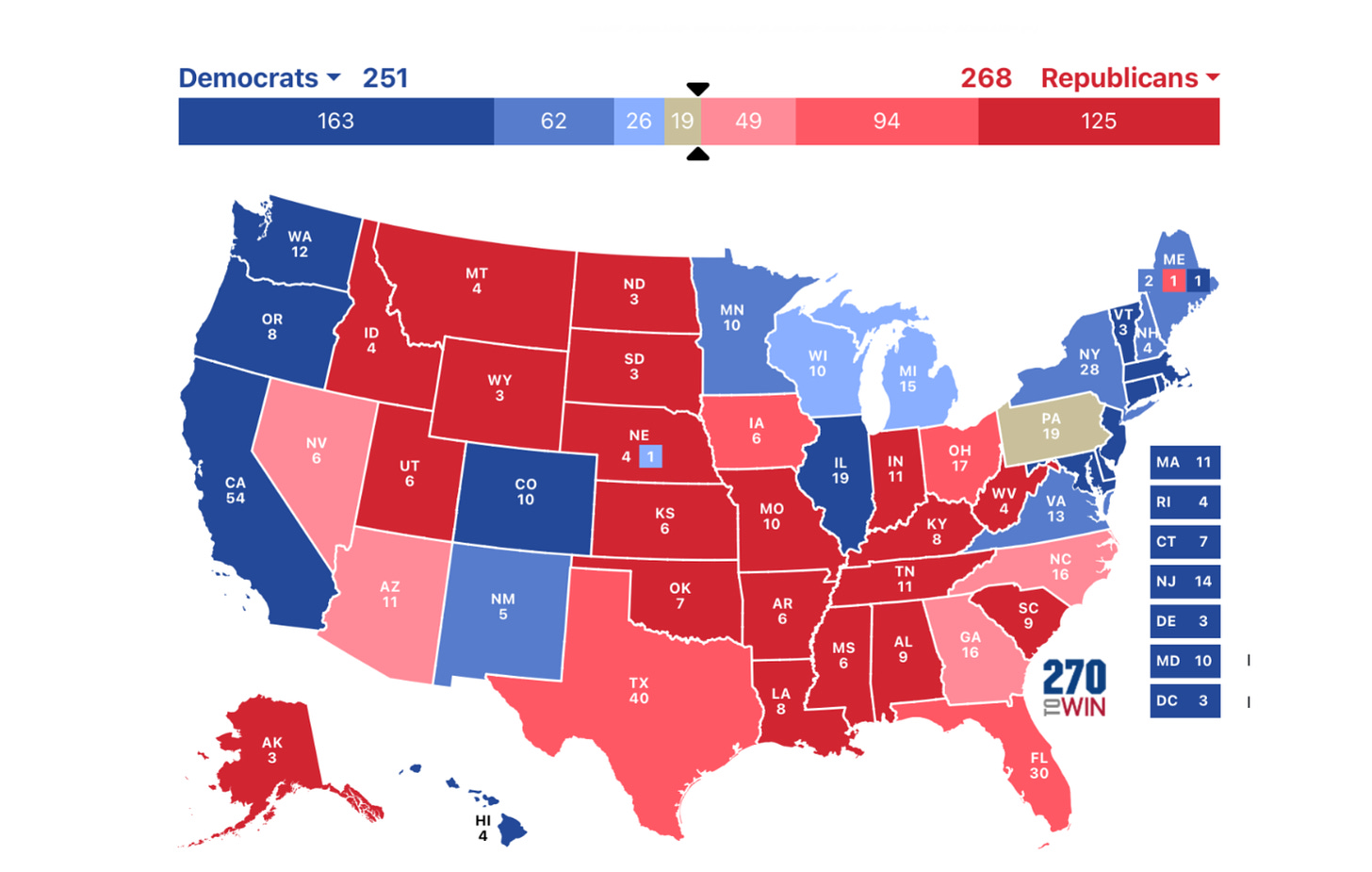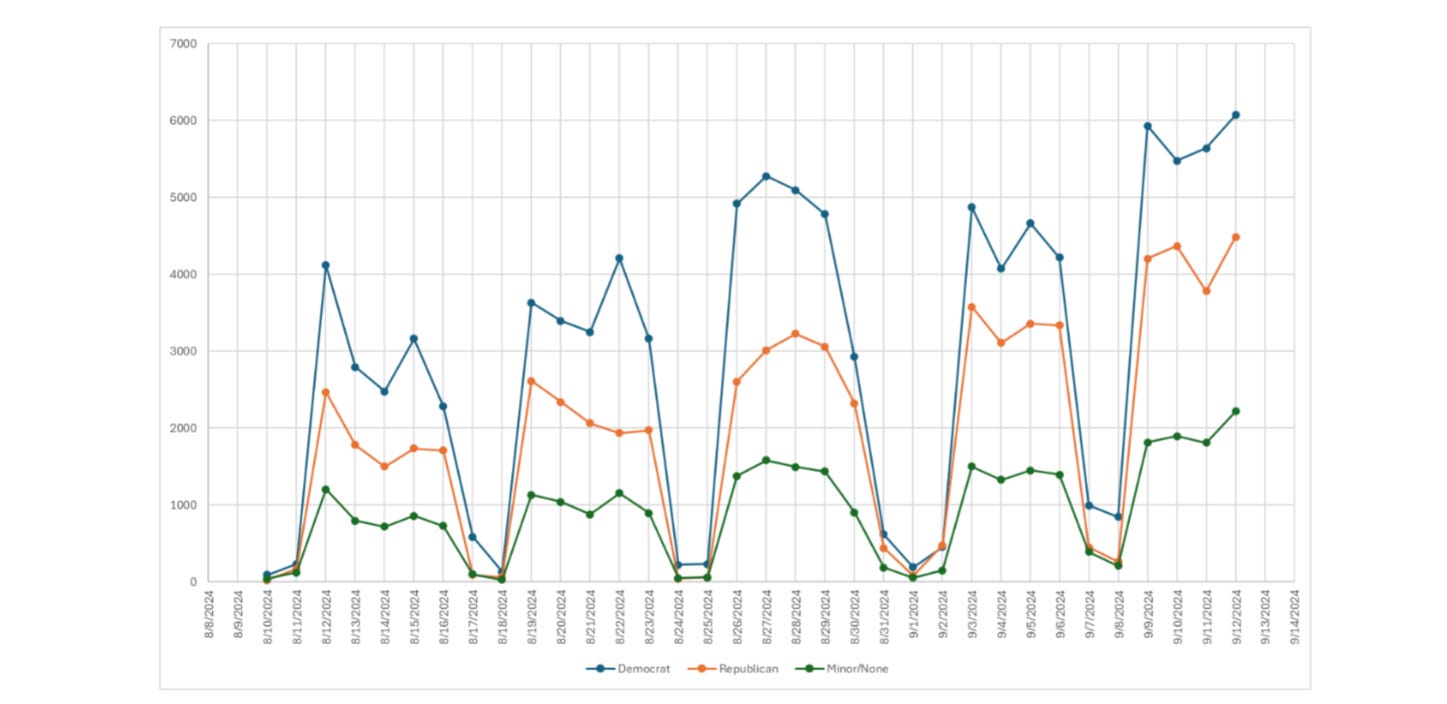There are seven weeks remaining till Election Day, and all eyes are on Pennsylvania. That’s because no matter how you slice it, whichever side wins the Keystone state has around a 90 percent chance of winning the White House.
That’s why election analysts held their collective breath yesterday as they awaited the first big nonpartisan, post-debate poll covering Pennsylvania. The Suffolk University survey of 500 likely voters came out last night, and to the relief of many Democrats, it found Harris with a three point lead in the state, 49 to 46.
A Republican leaning polling outfit, InsiderAdvantage, tried to rain on the parade by releasing its own partisan poll last night showing Trump ahead by two, but we shouldn’t give much oxygen to any poll these days paid for by the GOP. It’s chum in the water designed to demoralize Democrats and, in the case of Trump, give him some basis to challenge the election results later.
For what it’s worth, according to VoteHub publisher Garrett Herrin, in 2022, InsiderAdvantage had an average bias toward the GOP of +3.8. Suffolk had a smaller GOP bias of +0.7 bias and the smallest average error of any pollster for the midterms, though as they say in finance, past performance is not predictive of future outcomes!
But wait a sec. Shouldn’t we generally ignore all the polls and just focus on winning? That’s a common and understandable position, but it needs a bit of nuance. Polls give us an admittedly imperfect snapshot of where we are now. And they should never be viewed as crystal balls for how Election Day will actually go. But they do tell us a lot about how things have moved, especially within the same poll, even with inherently imprecise methodology. And they do tell us something about where a candidate’s support is generally coming from and what work still remains. Seen in this way, quality, nonpartisan polls are signals that the campaigns and the public should heed but never get complacent about.
Today I want to walk through why Pennsylvania and its 19 Electoral College votes matter so much. Then I’ll discuss the Suffolk poll and its findings, particularly as it relates to some deep dives on swing counties that are key to the election and how it stacks up to what we are seeing nationally.
It’s hard to win without those 19 Electoral College votes
Pennsylvania is the battleground state with the most number of Electoral College votes to award to the state’s popular vote winner. Let’s assume Vice President Kamala Harris won the Southwestern and Northern “blue wall” states, but failed to achieve her “reach” goals in the South. As we wait for mail-in ballots in Pennsylvania to be fully counted, since by law they can’t start counting until Election Day, the electoral map would look like this:
That’s a bit ulcer inducing. A win by Trump in Pennsylvania would put him at precisely 270 Electoral College votes, just enough to win the presidency. A win by Harris would put her over the top, but she can’t get there without Pennsylvania.
Now, let’s say Harris doesn’t win enough Latino votes to hang onto Nevada or Arizona either. How does that electoral map look? It’s actually the same story in reverse, with Harris needing Pennsylvania to put her exactly at 270, assuming she also wins the split Nebraska vote in NE-2:
It’s a bit wild when you realize that both sides need Pennsylvania to win in these two scenarios, both of which are quite within the realm of possibility. (Harris’s chances increase strongly, however, if she wins either of the two Southern states of Georgia or North Carolina and one of the Southwestern states of Arizona or Nevada. Another way to think about this is to say that Trump needs to hold a “red wall” in the South, while Harris needs her “blue wall” in the North to hold.)
The importance of Pennsylvania is therefore well understood by both campaigns. And that’s precisely why they are spending so much time and money there. It’s also why the first post-debate poll out the gate was so highly anticipated.
The Suffolk poll, county level remix
Beyond its baseline finding that Harris leads Trump statewide by three points, the Suffolk survey did something else quite interesting. It also separately polled 600 likely voters in two key swing counties in the state to see how the electorate viewed the candidates. Erie and Northampton are considered true swing counties that often act as bellwethers for which party will carry the state, so Suffolk chose them to do a deeper dive.
Erie County is in Northwestern Pennsylvania. Both Harris and Walz have recently visited there, signifying its importance to the campaign. Erie is an older industrial county that Trump won by 2 points in 2016, but he lost it to Biden by a single point in 2020. The Bulwark describes Erie as “home to many of the white, working-class Rust Belt voters both parties have been competing over for years” but concedes that “there’s not much either side can do to restore its former industrial glory.” It’s also an older county, with 18 percent of the residents over the age of 65, so even a big investment into a new industrial corridor by the Biden administration matters less to voters there than the price of gasoline and groceries and whether retirement benefits can keep up with inflation. Despite a more skeptical older electorate, Harris leads Trump in Erie County by four points, and that’s rather important.
Northampton County is in Eastern Pennsylvania and includes the cities of Easton and Bethlehem. Trump won the county by four points in 2016, but Biden took it by one point in 2020. If Erie County is defined by its older population, a driving force within Northampton is its Latino population, which comprises 13 percent of the county. Harris dominates Trump among this group, leading him 60 to 25 percent in a survey of 300 likely voters. That helped give Harris a five point lead over Trump in Northampton County, almost to the edge of the 5.7 percent margin of error.
The gap that keeps on giving
What accounts for Harris’s strength, at least as indicated by these new Suffolk polls? There’s no mistaking it: It’s the huge gender gap that has opened between Harris and Trump. As USA Today reported when publishing the Suffolk survey results,
In Northampton, Harris leads female voters 55%-37% — an 18-point advantage that is greater than Harris’ 17-point statewide lead with female voters. In Erie, Harris leads female voters by an even wider 55%-35% margin. Trump leads among male voters in Northampton 53%-44% and male voters in Erie 52%-42%.
“This is female-gender advantage on steroids,” said Dave Paleologos, director of the Suffolk University Political Research Center. “In all three data sets, the women margin is around almost twice around Trump’s edge among men.”
The gap with women Trump faces in Pennsylvania is something we have seen in national polls as well. And it’s a growing problem for his campaign. As Politico reported last week,
A recent ABC News/Ipsos poll has the gap at 18 points, a widening from their previous surveys that would blow away the 12-point gender gap from 2020 and the 11-point gender gap in 2016. If women continue to turn out to vote at a higher rate than men, like [they] have in every presidential election since 1980, it could cost him the election.
With all caveats
The Suffolk statewide Pennsylvania survey importantly also found that Harris leads with independents 43 to 38, with a large number still undecided, and that she enjoys a net +2 favorability, while Trump is underwater at -11.
But the Harris campaign isn’t taking anything for granted. After all, the polls badly undercounted Trump’s support in both of the past presidential elections. That could happen again, and if the miss is as high as before, Harris is actually trailing Trump in the state.
Before you climb back up the wall, I personally do not believe that the big polling miss of past presidential elections is happening today. If anything, as I’ve written about before with respect to Pennsylvania, the polls appear to be overestimating Trump’s strength, just as they overestimated GOP strength in the 2022 primaries.
For example, Trump actually lost between 20 to 25 percent of Republican primary voters in Pennsylvania, something not picked up by the polls, which would spell disaster for his campaign if many of those same “Haley” voters stayed home or crossed over to Harris.
Another point of caution: Republicans have done quite well with new voter registrations, outpacing Democrats up until Biden dropped out. There are indications that Democrats are now playing catch up, and that many of the young unaffiliated voters who are registering to vote will break for the Democrats. But only time will tell, and we need to assume the GOP will keep up the pressure. Presently, the parties are near even in overall voter registrations, with Democrats holding a slight advantage of 3.93m to 3.58m, or approximately 343,000 voters.
Mail-in ballots will be determinative
Just to get really granular and geeky, I am also watching for signs of enthusiasm in the applications for mail-in ballots. In 2020, it was the outstanding mail-in ballots, which would go on to break heavily for Democrats, that allowed me to predict with confidence on Election Night 2020 that Biden would carry the state by over 70K votes.
Democrats have traditionally outpaced Republicans on the use of mail-in ballots, but the 2020 election was held during the pandemic, so the overall numbers of voters using mail-in ballots may shift strongly in 2024. So far, however, things are moving as expected, as this chart of mail-in ballots processed over time shows. (Note: The dips in this chart are weekends when applications are not processed.)
For those who prefer to hear actual numbers, McDonald further reports:
For the four days in the week prior to the debate (Monday was Labor Day), registered Democrats outpaced registered Republicans by an average of 886 mail-in ballot applications a day. In the four days of this week (excepting Friday since we don’t have that data yet), Democrats outpaced Republicans by an average of 1,570 mail-in ballot applications a day. Democrats saw their first day above 6,000 applications processed on Thursday (6,075 to be exact).
Putting it together
Bottom line? Harris is looking decent in the state with just under 50 days to go. There are still a small handful of undecideds in the state, but if things stay on track, a bit more of them will likely break toward Harris over Trump unless something big changes.
Harris is looking strong in critical, bellwether swing counties such as Erie and Northampton, and she is putting up solid numbers with Latino voters while holding her own with seniors. She has work to do to win over male voters, but women are giving her an even bigger edge over Trump.
This puts Harris in a better position overall to win the state, but nothing can be, or will be, taken for granted.
One final note: Today is National Voter Registration Day. This is a perfect time to check the status of your registration at vote.gov and remind everyone you know to register if they haven’t already.
Deep breath. This election is very winnable.








The last time the NYT polls showed trump leading, I went to the cross tabs. What did I find? The times is STILL over sampling republicans (3 points), and conservatives (14 points). The are also under sampling young voters 18-44.
Side note about Insider Advantage; they don't allow you to see their cross tabs, so you can't tell the demographics they are covering in their polls.
Thanks Jay. This is great to hear. It’s definitely winnable if we all do our jobs — volunteer, donate, represent, and VOTE!